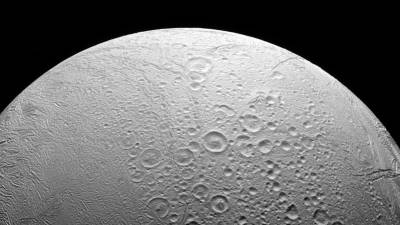PARIS: Scientists have discovered complex organic molecules within the hidden ocean beneath the icy shell of Saturn’s moon Enceladus.
This finding provides further evidence that the small celestial body may possess all necessary ingredients to support extraterrestrial life.
Enceladus measures just 500 kilometres wide and appears as a white, scar-covered moon invisible to the naked eye.
For many years, researchers considered Enceladus too distant from the Sun and consequently too cold to sustain life.
The Cassini space probe transformed this understanding during its 2004-2017 mission to Saturn and its rings.
Cassini’s flybys revealed that a vast saltwater ocean lies concealed beneath kilometres of surface ice.
Subsequent analysis of Cassini’s data showed this ocean contains numerous elements essential for life.
These elements include salt, methane, carbon dioxide and phosphorus.
The spacecraft detected jets of water erupting through surface cracks near the moon’s south pole.
These jets propelled tiny ice particles smaller than sand grains into space.
Some particles fell back to Enceladus while others accumulated around Saturn’s E ring.
Nozair Khawaja from the Free University of Berlin stated that Cassini constantly detected Enceladus samples while flying through Saturn’s E ring.
Previous examination of these particles identified various organic molecules including amino acid precursors.
Scientists worried these ice grains might have undergone alteration during centuries in the ring or exposure to cosmic radiation.
Researchers therefore sought to analyse fresher ice grains for more reliable data.
Cassini had collected such samples during a 2008 flight directly through the moon’s surface spray.
Ice grains struck the spacecraft’s Cosmic Dust Analyzer at approximately 18 kilometres per second during that encounter.
Completing a detailed chemical analysis of these particles required several years of work.
Study co-author Frank Postberg confirmed the complex organic molecules are readily available within Enceladus’s ocean.
French astrochemist Caroline Freissinet expressed little doubt that these molecules originate from the moon’s subsurface sea.
She described this confirmation as another important piece in the scientific puzzle.
Freissinet noted that modern technology like artificial intelligence enables new analysis of existing data.
She suggested that future missions should land near Enceladus’s geysers to collect direct samples.
The European Space Agency is currently studying potential missions designed for this purpose.
The agency stated that Enceladus ticks all boxes for being a habitable environment capable of supporting life.
Khawaja added that even failing to find life on Enceladus would represent a major scientific discovery.
Such an outcome would raise profound questions about why life remains absent despite apparently suitable conditions. – AFP
